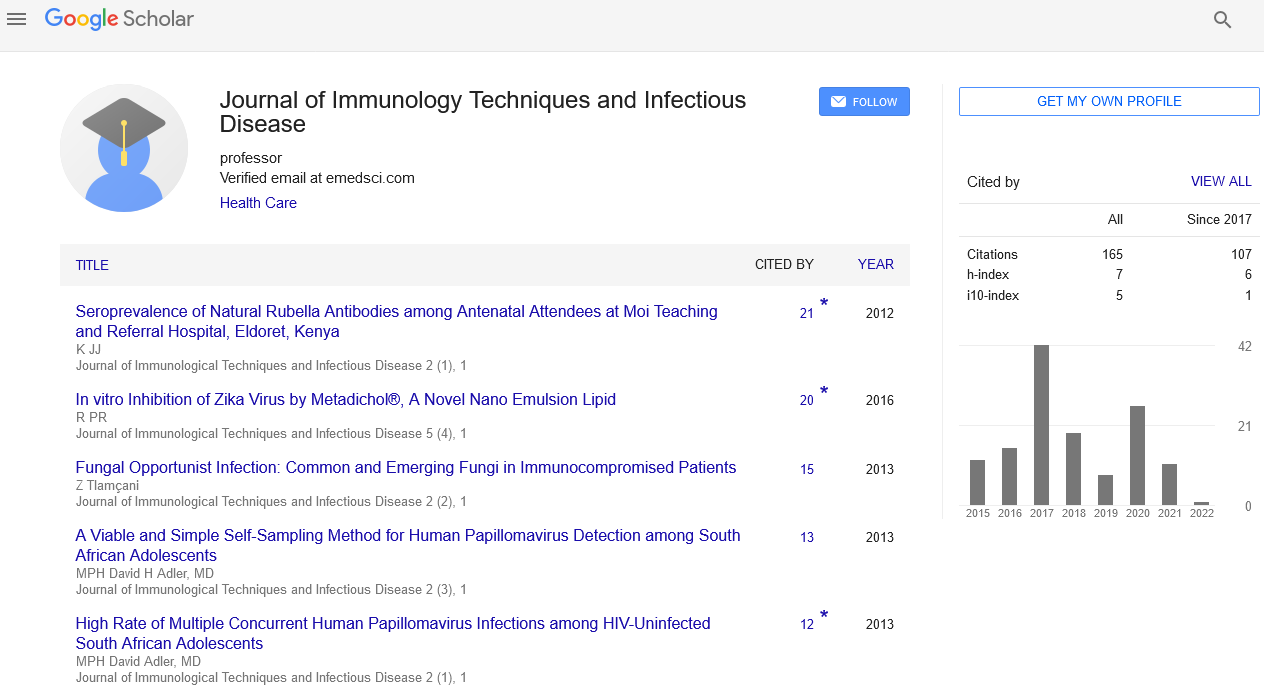Commentary, J Immunol Tech Infect Dis Vol: 13 Issue: 2
Characteristics, Prevention, and Treatment Procedures for Pathogenic Microorganisms
Zhang Haimin*
1Department of Immunology, Chengdu University of Traditional Chinese Medicine, Chengdu, China
*Corresponding Author: Zhang Haimin,
Department of Immunology, Chengdu
University of Traditional Chinese Medicine, Chengdu, China
E-mail: haim.zha@gmail.com
Received date: 28 May, 2024, Manuscript No. JIDIT-24-146416;
Editor assigned date: 31 May, 2024, PreQC No. JIDIT-24-146416 (PQ);
Reviewed date: 14 June, 2024, QC No. JIDIT-24-146416;
Revised date: 21 June, 2024, Manuscript No. JIDIT-24-146416 (R);
Published date: 28 June, 2024, DOI: 10.4172/2329-9541.1000383.
Citation: Haimin Z (2024) Characteristics, Prevention, and Treatment Procedures for Pathogenic Microorganisms. J Immunol Tech Infect Dis 13:2.
Description
Pathogenic microorganisms are microscopic entities capable of causing disease in humans, animals, and plants. Bacteria, viruses, fungi, and parasites all are microorganisms with different characteristics and methods for a viral infection.
Characteristics of pathogenic bacteria
Bacteria are single-celled prokaryotic organisms with diverse shapes, sizes, and metabolic capabilities. While many bacteria are harmless or beneficial, some are pathogenic and can cause severe diseases. Gram staining bacteria are classified as Gram-positive or Gram-negative based on their cell wall structure, which influences their susceptibility to antibiotics. Gram-positive bacteria have thick peptidoglycan layers, while Gram-negative bacteria have thinner layers but possess an outer membrane. Shapes and arrangements of bacteria can be cocci (spherical), bacilli (rod-shaped), or spirilla (spiral-shaped). They can occur in individual cells, pairs, chains, or clusters.
Prevention and control
Preventing and controlling infections caused by pathogenic microorganisms involves a combination of public health measures, vaccination, and hygiene practices. Vaccines are essential for preventing viral and bacterial infections, such as measles, influenza, and tuberculosis. Proper sanitation and hygiene practices are essential for preventing the spread of infectious diseases. Reducing contact with vectors, such as mosquitoes and ticks, through measures such as insecticide use and protective clothing, helps to prevent vector-borne diseases.
Treatment approaches
Pathogenic therapy methods include the following:
Antibiotics used to treat bacterial infections, antibiotics must be chosen based on the pathogen's susceptibility to avoid resistance.
Antiviral drugs target specific stages of the viral life cycle, such as entry, replication, or release. Examples include antiretroviral for HIV and antivirals for influenza. Antifungal medications used to treat fungal infections; these drugs target fungal cell membranes or cell wall synthesis. Common antifungals include azoles and echinocandins. Antiparasitic drugs, such as malaria medications and antihelminthics, are used to treat parasitic illnesses.
Examples of viral infections
Some significant viral infections are:
Influenza: It is caused by influenza viruses, the flu is a highly contagious respiratory illness characterized by fever, cough, sore throat, and muscle aches. Annual vaccination is recommended to prevent severe outcomes.
Human Immunodeficiency Virus (HIV): HIV targets the immune system, specifically CD4+ T cells, leading to immunodeficiency. Without treatment, HIV progresses to Acquired Immunodeficiency Syndrome (AIDS), increasing susceptibility to opportunistic infections.
COVID-19: Caused by the novel coronavirus SARS-CoV-2, COVID-19 emerged in late 2019 and led to a global pandemic. It primarily affects the respiratory system but it can cause severe complications in multiple organ systems.
Fungi: The Opportunistic Pathogens fungi are eukaryotic organisms that can be unicellular (yeasts) or multicellular (molds and mushrooms).
Risk factors
The major risk factors are:
Lack of access to clean water: Populations without access to safe drinking water are at higher risk of waterborne diseases.
Inadequate sanitation and hygiene: Poor sanitation practices and lack of hygiene education contribute to the spread of waterborne pathogens.
Climate and environmental conditions: Flooding, heavy rainfall, and poor drainage can contaminate water sources and facilitate the spread of waterborne diseases.
Challenges and future directions
Despite progress in preventing and controlling waterborne diseases, several challenges remain, particularly in low-resource settings. Ensuring the sustainability of water, sanitation, and hygiene interventions requires ongoing funding, maintenance, and community involvement. Climate change impacts, such as increased flooding and changes in water availability, provide novel challenges to preventing waterborne illnesses. The emergence of antimicrobial resistance in waterborne pathogens complicates treatment options and underscores the need for prudent use of antibiotics and development of new treatments.
 Spanish
Spanish  Chinese
Chinese  Russian
Russian  German
German  French
French  Japanese
Japanese  Portuguese
Portuguese  Hindi
Hindi 
